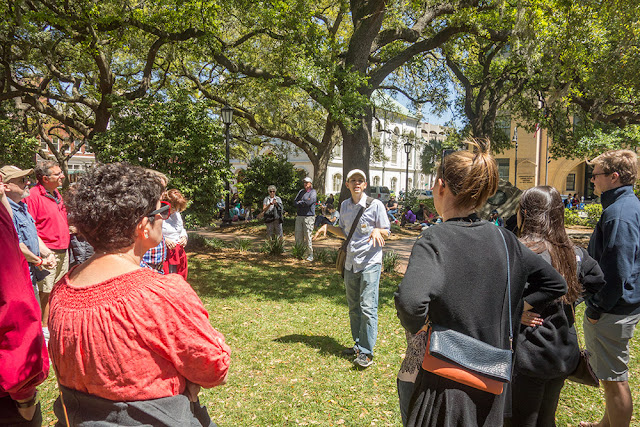We decided to go on another guided walking tour in Charleston.
This time we choose a Civil War tour. Our guide was very knowledgeable, and I felt I learned many new things about the Civil War.
As I have mentioned before, when on these tours I tend to give more attention to listening than to looking for good pictures, but here are a few that I took in the old town area of Charleston:
Some of the early residents felt they needed to protect their homes from possible slave uprisings. Of course, this wrought iron work was made with highly skilled slave labor.
Some of the iron work is less intimidating.
This wall detail caught my eye as we walked past it.
Part of the way our guide told the story of Charleston was by taking us from square to square in the old city. Each is a square block itself, and only a few blocks from the next. Each is graced by wonderful old live oaks, and commemorative statuary. Nowadays they are beautiful islands where tourists walk and locals bring their dogs or have their lunch breaks. Originally they were a place for community ovens and other such activities.
Almost all of the homes and buildings in Charleston were destroyed by bombardment during the Civil War, but have been beautifully restored. I'm sure their interiors are quite modern.
As in many old towns, horse drawn carriages are also used for tours.
Our next stop up the coast was Myrtle Beach, South Carolina. We stayed at the state park which was very nice.
On Sunday we went over to the pier and for a walk along the beach. This was within the State Park. Our campground was in the trees that you see inland from the sand.
We are coming to terms with the tradeoff between having a peaceful wooded site, where the satellite is blocked, vs. an open, treeless site where we can get satellite reception. I have become a bit of a political addict and Craig likes to watch sports. We have been lucky in that our Verizon phone is our hot spot and has been working quite well. We have an unlimited data plan, so in a pinch we have been able to stream the NBA playoffs and some of the CNN election coverage. We can also get local and network TV on the Alfa's original antenna if we want it.
On the first day we took a guided garden tour. Although the flowers were very nice, they were secondary to the magnificent sculpture collection. All of the 1400 sculptures are figurative and by American artists.
 |
| Gator Bender by Nathaniel Choate
This was one of my favorites, I think I liked the back view best! Nice buns.
|








































